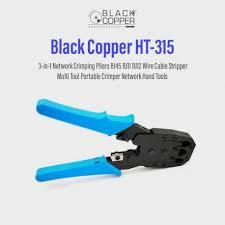Crimping Tool: The Essential Guide for Perfect Connections

1. Introduction: What Is a Crimping Tool?
A crimping tool is a hand or power tool used to join two materials—typically metal and wire—by deforming one or both of them to hold each other. In simpler terms, it creates a strong mechanical bond without the need for soldering. Whether you're an electrician, network technician, or DIY enthusiast, a crimping tool ensures reliable and long-lasting connections.
2. How Does a Crimping Tool Work?
Crimping tools work by compressing a connector (like a terminal or plug) around the stripped end of a wire. The process involves:
-
Stripping the insulation from the wire.
-
Inserting the wire into a connector.
-
Using the crimping tool to press and secure the connection.
This process ensures a solid electrical or mechanical joint that resists loosening over time, which is crucial for safety and performance.
3. Types of Crimping Tools
Not all crimping tools are the same. Choosing the right one depends on your task:
a. Handheld Crimping Tools
Perfect for small-scale electrical jobs, these are compact and easy to use. Ideal for electricians and hobbyists.
b. Ratchet Crimping Tools
These offer consistent pressure, ensuring every crimp is uniform. They are widely used in network cable installations.
c. Hydraulic Crimping Tools
Designed for heavy-duty applications, hydraulic crimpers apply more force with less effort—perfect for industrial or automotive work.
d. Automatic Crimping Machines
Used in manufacturing, these machines can handle mass production, providing speed and precision.
4. Applications of Crimping Tools
Crimping tools are found across multiple industries:
-
Electrical Wiring: Creating terminals, tool crimping, and cable lugs.
-
Telecommunications: Assembling Ethernet and coaxial cables.
-
Automotive: Securing wiring harnesses.
-
Aerospace and Marine: Ensuring vibration-resistant connections.
Essentially, anywhere a secure, corrosion-resistant electrical connection is needed, a crimping tool plays a key role.
5. How to Choose the Right Crimping Tool
When selecting a crimping tool, consider:
-
Wire Gauge Compatibility: Make sure the tool matches your wire size.
-
Connector Type: Each connector (RJ45, coaxial, insulated terminal) requires a specific crimping profile.
-
Build Quality: Tools made from high-grade steel last longer and provide consistent performance.
-
Ergonomic Design: Comfortable handles reduce fatigue during prolonged use.
6. Maintenance Tips for Crimping Tools
To extend the life of your tool:
-
Clean regularly to remove dirt or debris.
-
Lubricate moving parts occasionally.
-
Store in a dry place to avoid rust.
-
Inspect jaws for wear or damage before use.
A well-maintained crimping tool ensures accuracy and prevents poor connections.
7. Advantages of Using a Crimping Tool
-
Consistent Connections: Delivers uniform results every time.
-
Time-Efficient: Faster than soldering.
-
Safe and Reliable: Reduces the risk of loose or overheated joints.
-
Professional Finish: Gives cables a clean, durable appearance.
8. Conclusion
A crimping tool might look simple, but it’s one of the most indispensable tools for anyone working with wires or cables. From DIY projects to industrial installations, having the right crimping tool ensures safety, reliability, and performance in every connection.
Whether you’re upgrading your home network or wiring a control panel, investing in a quality crimping tool pays off with precision and durability.
For the Information: Click Here
- Art
- Crafts
- Drinks
- Fitness
- Food
- Spellen
- Health
- Home
- Literature
- Music
- Networking
- Finance
- Other
- Hotels
- Shopping
- Sports
- Wellness


